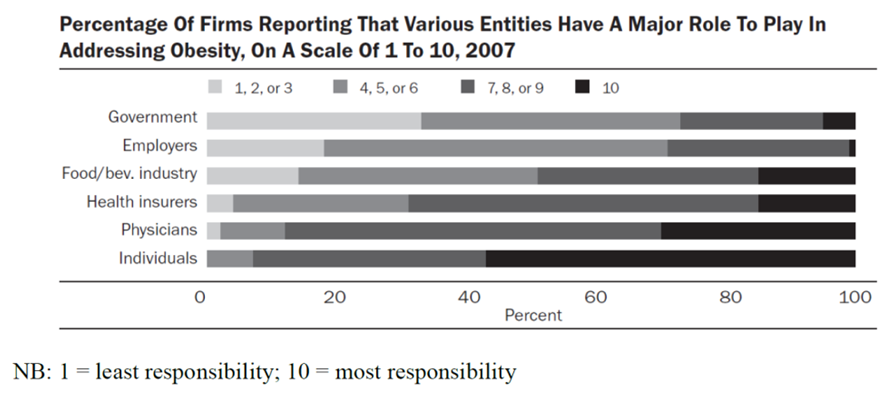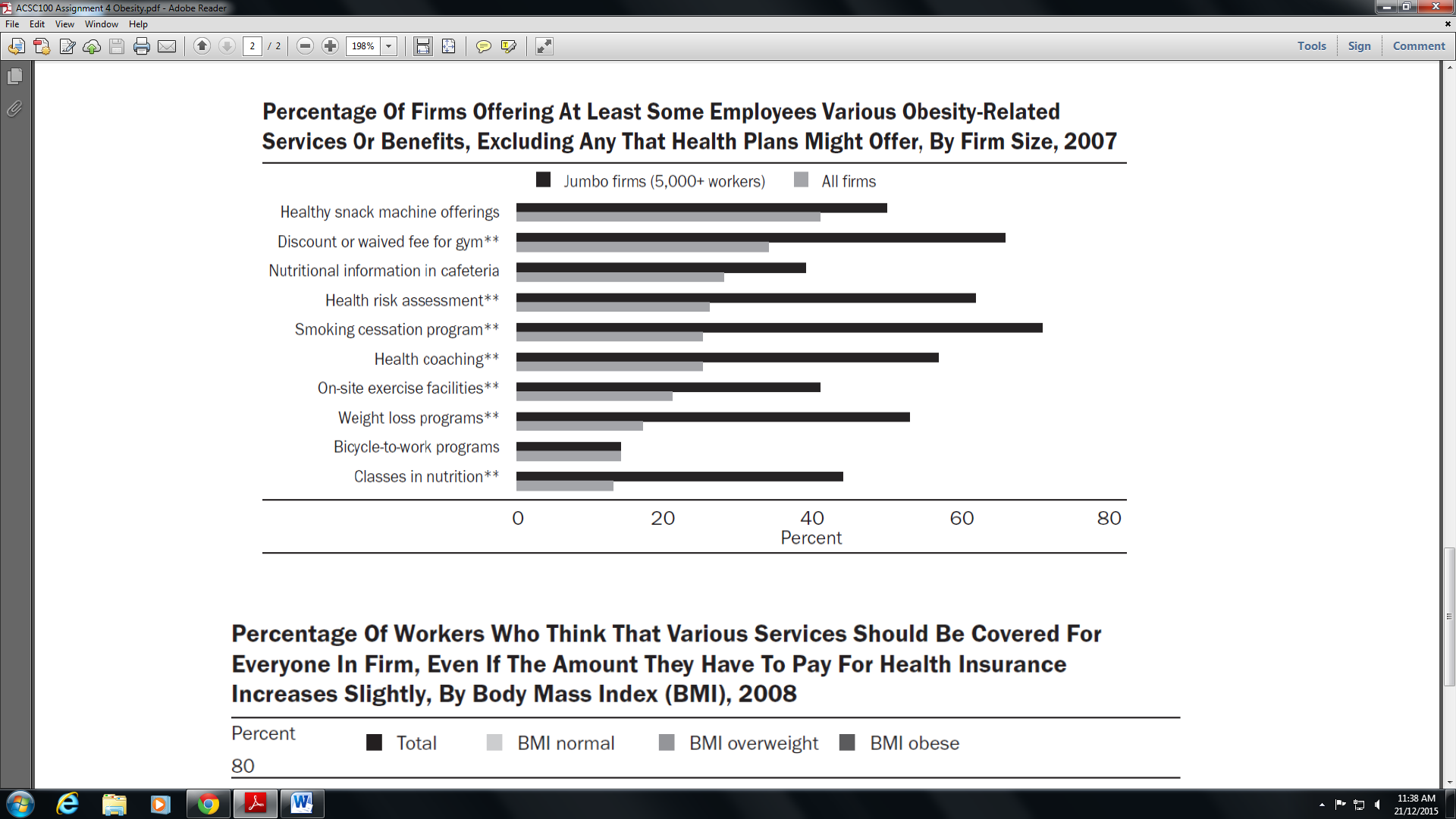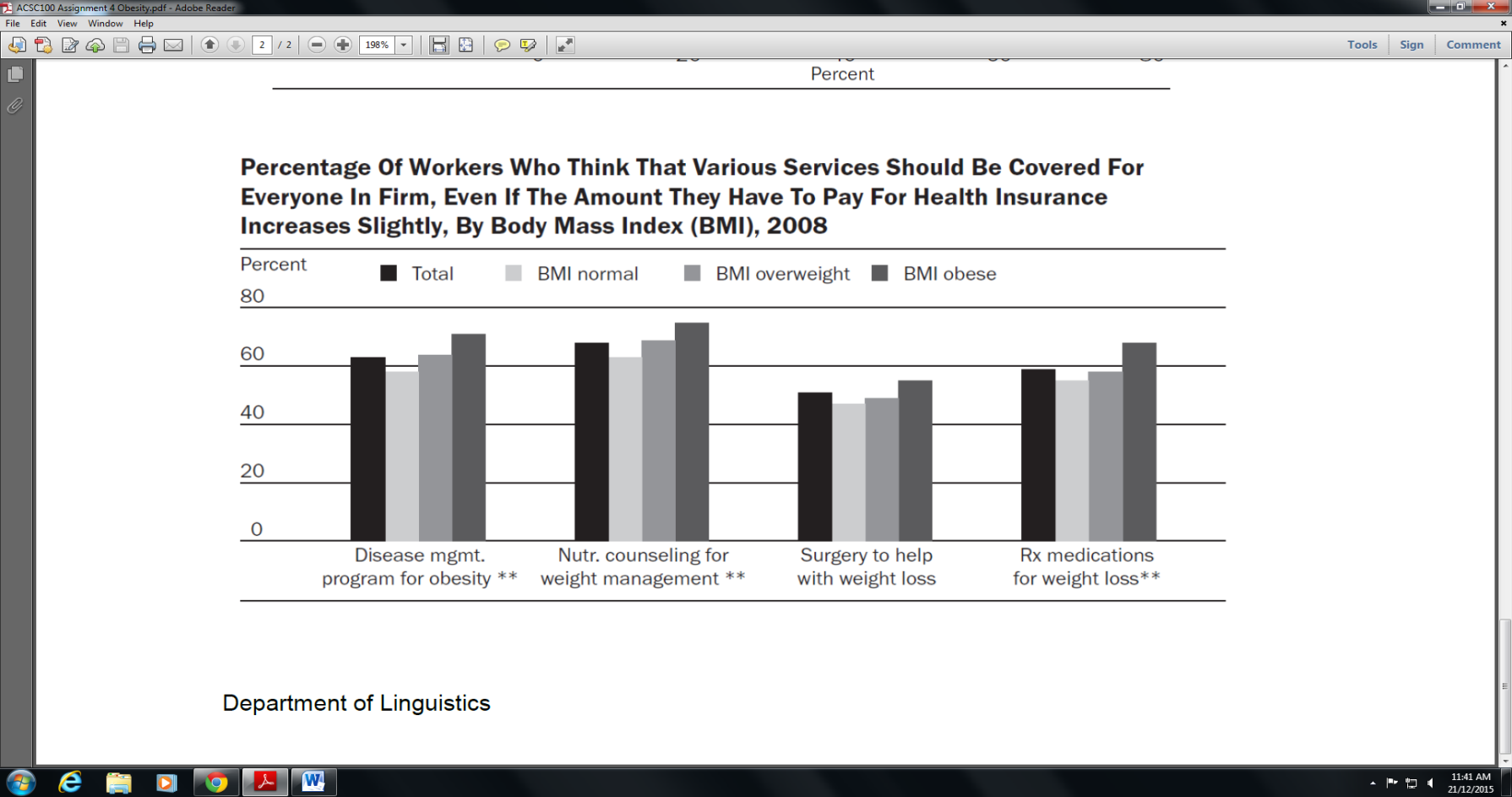Abstract
Overweight and obesity are the causes of several workplace problems for employers, namely higher rates of injuries and absenteeism, lower productivity, and higher insurance-related expenses. However, it appears that not many companies have implemented obesity-related programs to help their employees. The present paper is a large-scale quantitative study consisting of structured surveys of both employers and employees regarding their perspective on the existence and desirability of such programs. The findings reveal a significant gap between the percentage of employers and workers who believe companies should provide obesity-related programs, as well as between large and small companies in the provision of such services.
The study is significant because it highlights two problems: firstly, employers are likely to be misinformed about the costs of employee obesity to them. Secondly, if they lack the resources to implement obesity-related programs, they do not have to bear the costs on their own.
Introduction
While certain diseases like AIDS, cancer, and Ebola receive significant worldwide attention, they are far from being the only health problems plaguing the modern world. One of the so-called “silent killer” diseases are overweight and obesity, especially prevalent in the developed countries (Swinburn, Gill & Kumanyika, 2005).
An Australian cross-sectional study, conducted as early as the beginning of the 2000s, discovered that approximately 60 percent of adults are either overweight or obese, regardless of whether the body mass index (BMI) or waist circumference is used as the defining measure. Moreover, this number has more than doubled in comparison to the previous study conducted 20 years earlier (Cameron, 2003). Currently, Australia is the world’s fourth-leading country in terms of its overweight and obese population, right after the United States, Mexico, and the United Kingdom (Australian Safety and Compensation Council, 2008).
The numbers are clearly staggering, and several calls for a comprehensive approach to solving this problem have been made by scientists, researchers, and policy-makers alike (Swinburn, Gill & Kumanyika, 2005; Ostbye, Dement & Krause, 2007; Australian Safety and Compensation Council, 2008). However, these action plans remain limited in scope as they typically target two main sub-problems: childhood obesity and individual behavior and lifestyle preferences (Swinburn, Gill & Kumanyika, 2005). While these issues are of utmost importance to combatting obesity, they nevertheless ignore a large segment of the population: working adults who have little time and other resources to make healthier life choices. Recently, the medical community issued a call for action for employers to provide obesity-related programs at their workplace (Ostbye, Dement & Krause, 2007; Australian Safety and Compensation Council, 2008; Chalupka, 2008).
It is not only a public health issue, as companies increasingly suffer from their employees’ obesity-related problems that result in higher rates of injuries and absenteeism, lower productivity, higher insurance-related expenses, as well as costs of accommodating weight and dimension requirements of heavier people (Australian Safety and Compensation Council, 2008). According to Ostbye, Dement, and Krause (2007), on average, employees with a BMI of 30 or higher cost the company seven times higher in medical claims and eleven times higher in indemnity claims, compared to the workers within the recommended weight range. Nevertheless, employers appear to remain reluctant about introducing obesity-related programs (Chalupka, 2008).
The present paper thus aims to examine both the employer and worker perspectives on responsibility and expectations on addressing obesity-related problems. The study consisted of a series of structured interviews with heads of human resources from 500 randomly selected companies with 50 or more workers (representing the employer perspective), as well as with 1,350 randomly selected workers who were a) 18–64 years of age; b) employed either full or part-time; and c) employed by a company with fifty or more employees. The results revealed a significant gap between the percentage of employers and workers who believe companies should provide obesity-related programs, as well as between large and small companies in the provision of such services. These findings are consistent with the evidence of employers’ reluctance to provide obesity-related programs, and they yield some important practical implications.
Results
The first interview recorded the employer’s perspective on what entity is responsible for providing obesity-related programs (Appendix A). As much as 60 percent of the respondents named the individual to be the most responsible, and none assigned little responsibility to them. Generally, employers tended to believe that health insurers and physicians have the most responsibility to address the problem. The government, together with employers, were believed to have little to moderate responsibility according to approximately 70 percent of those surveyed.
The second gathered the data on how many companies offer weight-related services to at least some of their employees, and the findings were reported separately on jumbo firms with more than 5,000 employees (Appendix B). Companies provided consistently few services, with the most popular ones being less expensive options such as healthy snack vending machines and gym discounts, provided by 35 and 40 percent, respectively. Jumbo companies were sometimes twice as likely to offer the whole range of services, even including nutrition classes. Some of the most popular services relate to general health rather than obesity or weight management, in particular – for instance, a smoking cessation program or an assessment of health risks.
Finally, the last survey examined the employee perspective on whether or not companies should provide various health services, even if it increases the insurance costs (Appendix C). Approximately half agreed that disease management and nutrition counseling programs were necessary, with the least support given to plastic surgery methods. The findings also indicate a consistent positive correlation between the workers’ BMI and their support for various health services provided by the company.
Discussion
These findings confirm the anecdotal evidence that employers are reluctant to provide obesity-related programs to their workers. Given the costs that companies bear because of the problem, one can assume that their attitude is uninformed. Like the rest of society, they believe the individual to be most responsible for solving the problem by changing their lifestyle and behavior. However, they seem to ignore their role in this matter, as most employees lead a sedentary lifestyle at work. Employers should be better informed about the costs of obesity to them.
Quite expectedly, large companies are more generous in providing obesity-related services to employees. Most likely, this is because large corporations have the resources to do so and also enjoy the economies of scale because of the size of their workforce. Consequently, smaller companies should be encouraged to invest in such programs, perhaps, in exchange for tax breaks or other insurance-related benefits. It is also predictable that people with a higher BMI will be more supportive of obesity-related programs as they are aware of the health problems and other challenges brought by excessive weight. Importantly, employees are willing to pay a higher insurance fee if such programs were introduced so the costs can be shared.
The implications of these studies are twofold. Firstly, it is clear that employers are not fully aware of the benefits of implementing obesity-related programs to them, as they would help solve such problems as absenteeism and low productivity. Secondly, the employers do not have to bear the associated expenses alone as workers are willing to contribute, as well, and there may be a possibility of funding from the government.



References
Australian Safety and Compensation Council 2008, Overweight and obesity: implications for workplace health and safety and workers’ compensation. Web.
Cameron, AJ, Welborn, TA, Zimmet, PZ, Dunstan, DW, Owen, N, Salmon, J, Dalton, M, Jolley, D & Shaw, JE 2003, ‘Overweight and obesity in Australia: the 1999–2000 Australian Diabetes, Obesity and Lifestyle Study’, Medical Journal of Australia, vol. 178, pp. 427-432. Web.
Chalupka, S 2008, ‘Workplace obesity prevention’, AAOHN Journal, vol. 59, no. 5, p. 236. Web.
Ostbye, T, Dement, JM & Krause, KM 2007, ‘Obesity and workers’ compensation: results from the Duke Health and Safety Surveillance System’, Archives of Internal Medicine, vol. 167, no. 8, pp. 766-773. Web.
Swinburn, B, Gill, T & Kumanyika, S 2005, ‘Obesity prevention: a proposed framework for translating evidence into action’, Obesity Reviews, vol. 6, pp. 23-33. Web.